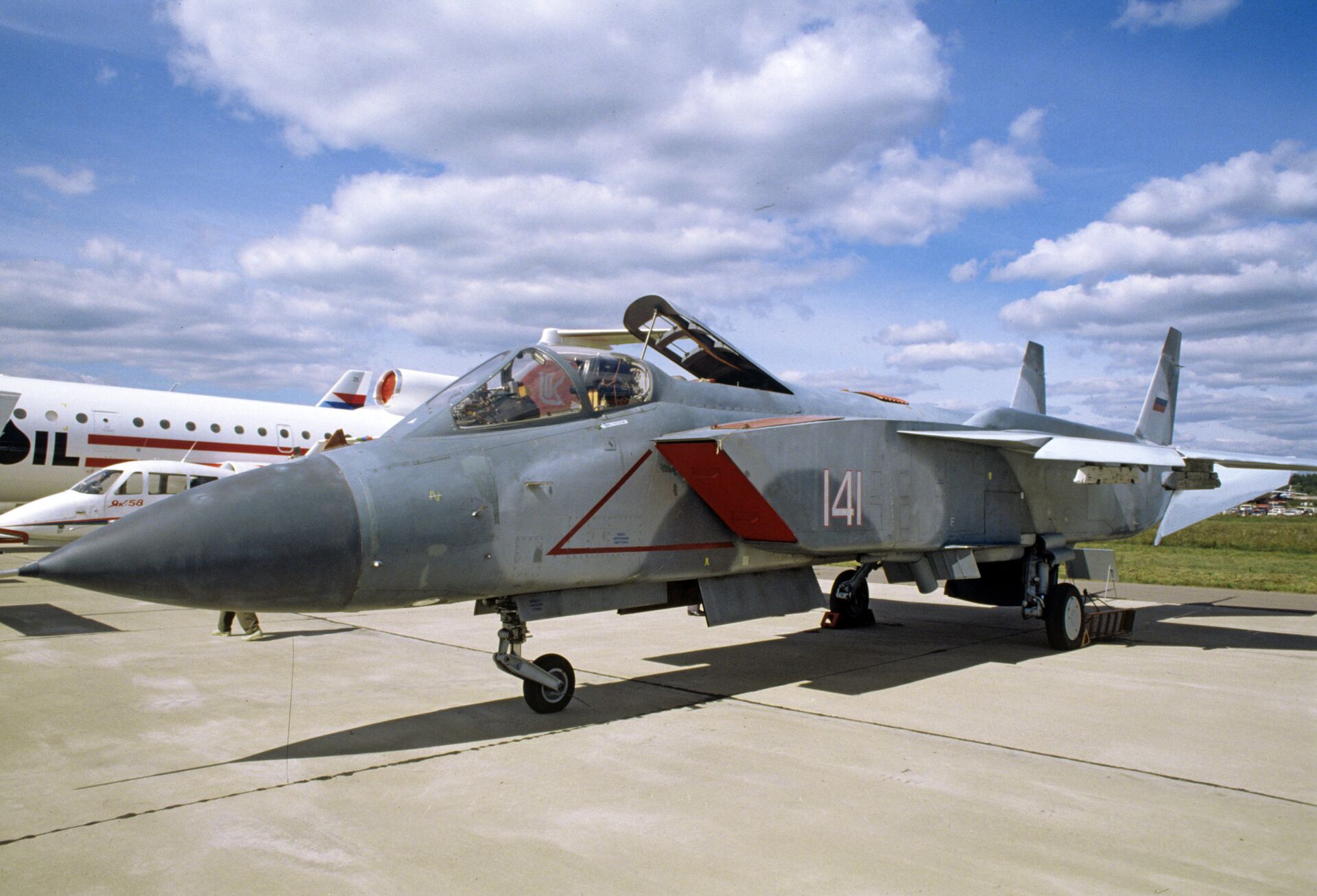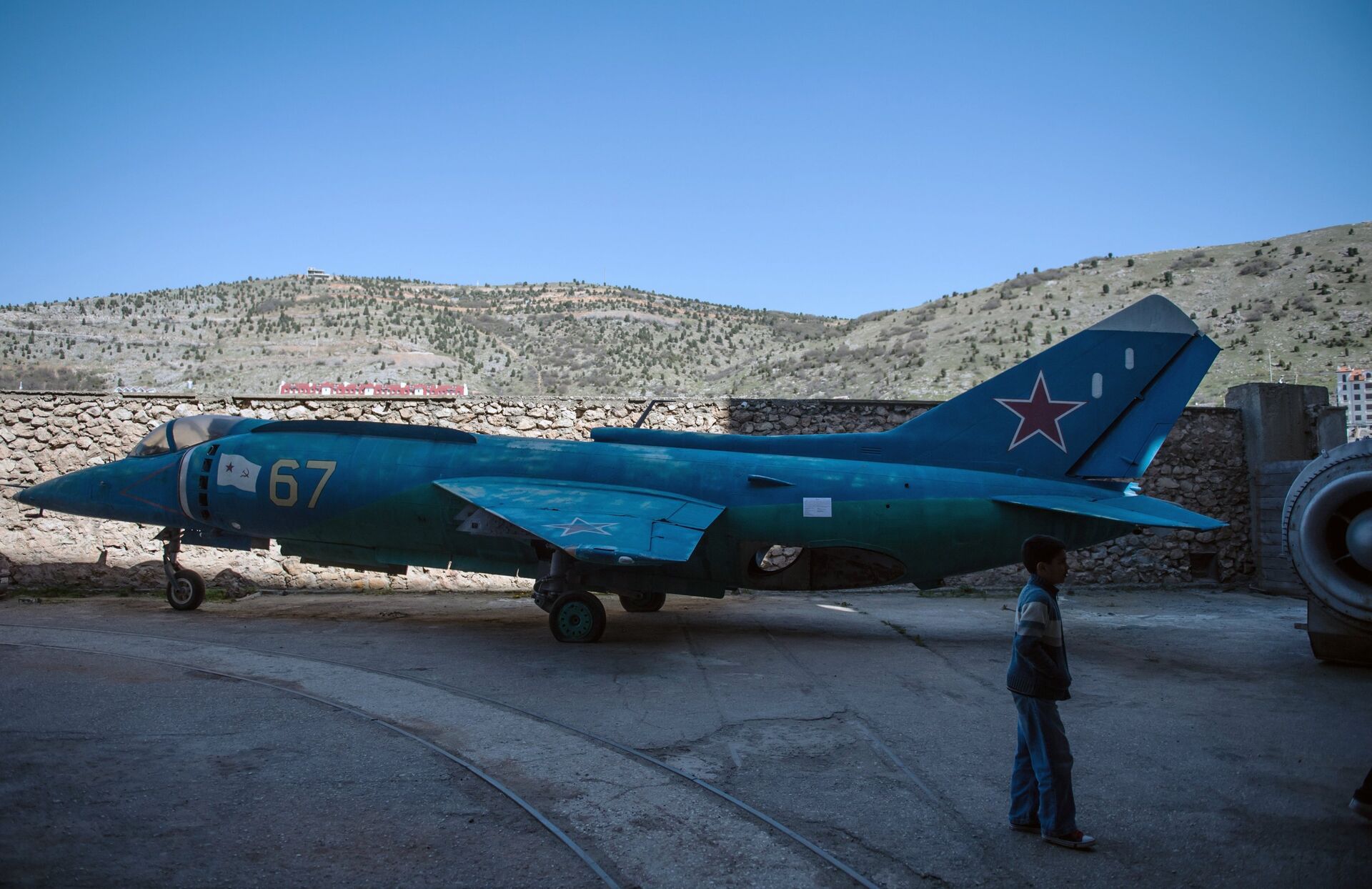https://sputnikglobe.com/20240727/russias-yakovlev-design-bureau-ready-to-resume-development-of-vertical-take-off-jets-1119536016.html
Russia’s Yakovlev Design Bureau Ready to Resume Development of Vertical Take-Off Jets
Russia’s Yakovlev Design Bureau Ready to Resume Development of Vertical Take-Off Jets
Sputnik International
Russian aircraft designer and manufacturer Yakovlev is ready to resume the development of a fifth-generation VTOL capable aircraft, Yakovlev general director Andrei Boginsky told Sputnik.
2024-07-27T18:48+0000
2024-07-27T18:48+0000
2024-07-27T18:48+0000
military
military & intelligence
andrei boginsky
ussr
russia
defense ministry
yak-38
f-35b
kh-31 (as-17 krypton) missile
https://cdn1.img.sputnikglobe.com/img/07e8/07/1b/1119535860_0:276:700:670_1920x0_80_0_0_b15307dcdfbaf7b7adf8b7500d944e59.png
Russian aircraft designer and manufacturer Yakovlev is ready to resume the development of a fifth-generation VTOL capable aircraft, if asked to do so by the Defense Ministry, Yakovlev general director Andrei Boginsky told Sputnik.“Our designers have explored the prospects for creating even more advanced aircraft corresponding to the level of the fifth generation of combat aviation,” Boginsky said. “The topic of vertical take-off and landing aircraft was frozen in the difficult 1990s, but we have retained the scientific and technical basis” for their development.Yakovlev began experimenting with VTOL technology in the 1950s, with these efforts leading to the development of the Yak-36, a VTOL technology demonstrator. The Yak-36 made its maiden flight sixty years ago, on July 27, 1964 in conventional flight mode. Two months later, on September 27, 1964, the aircraft performed its first hover and transition to horizontal flight. A full profile flight with vertical take-off and landing took place in March 1966.Four Yak-36 prototypes were built, with the project seeing extensive testing and tinkering to try to improve airflow and flight characteristics. The Yak-36 program was redesignated the Yak-36M program, and ultimately gave birth to the Yak-38 program. The latter resulted in the successful introduction of the Yak-38 into Soviet Naval Aviation in 1976 for use aboard Project 1143 Krechyet (lit. ‘Gyrfalcon’) Kiev-class aircraft carriers, which would carry a standard compliment of a dozen Yak-38s.These unique, three-engined aircraft (1 Tumansky R-28 V-300 vectored thrust turbofan and 2 RD-38 turbojets) had a crew of one, a top speed up of nearly 1,300 km per hour, an 11 km service ceiling and a practical combat radius with vertical takeoff and landing and full weapons complement of up to 185 km.The jets were armed with 23 mm autocannons and had four hard points for up to 2 tons of munitions, from Kh-23 air-to-surface and R-60 air-to-air missiles to cluster, incendiary and FAB series free-fall bombs. RN-28, RN-40 and RN-41 tactical nuclear weapons, designed for operations against enemy carrier groups, were also available. The Yak-38 proved finicky in exploitation, with scores of the roughly 230 Yak-38s that were built lost in accidents. Yakovlev consequently worked to improve its VTOL technology in its future iterations.The design bureau began design of the Yak-38’s successor, the Yak-141, in 1975, based on demands by the Defense Ministry that the next generation of Soviet VTOL aircraft have improved maneuverability and thrust-to-weight ratio, fully automated vertical take-off capability, smaller braking distance, onboard radar, and more powerful engines to increase weapons payload and extend the combat radius to 900 km.The Yak-141 reached an advanced stage of development, with four prototypes built and the first flight taking place in 1987. In 1989, the first vertical takeoff took place, and in 1990 the plane carried out its first full profile flight, and first successful takeoff and landing from and on a carrier. On October 5, 1990, one of the test aircraft was lost in a crash, but the pilot survived unscathed.The Yak-141 had foldable wings, a 19.5 ton maximum takeoff weight from runway (and 15.8 ton max VTOL), three digitally-controlled engines – an R79V-300 lifting and propulsion engine and twin RD-41 lifting engines. The plane could accelerate to up to 1,250 km per hour, making it the first VTOL plane in the world flying faster than the speed of sound, and a 15 km service ceiling.The aircraft was designed to be armed with a 30 mm GSh-30-1 autocannon, and had five hardpoints for R-77, R-27, R-73 and R-60 air-to-air missiles, Kh-25, Kh-31 and Kh-35 air-to-surface guided missiles, optional secondary 23 mm cannons, or up to six free-fall bombs with a caliber up to 500 kg. In addition to base Project 1143 and Project 1143.5 carriers, Yak-141 would have been carried aboard Ulyanovsk-series nuclear-powered aircraft carriers.While the Yak-141 never went into service thanks to the USSR’s collapse, its legacy lived on, with blueprints for the planes sold to Lockheed in the 1990s and used by the US defense giant to help develop the F-35B. As the F-35B’s development demonstrated, a modern VTOL jet requires miniaturization of avionics and an airframe able to handle the G-force requirements of modern aircraft engines for VTOL-capable aircraft.4++ and 5thgeneration technologies developed for other Russian combat aircraft could be applied to a next-gen Russian VTOL jet, including modern avionics and weapons, and they are expected to be carried by either a new Russian aircraft carrier, or a new generation of amphibious assault ships.
https://sputnikglobe.com/20240710/top-five-fifth-gen-jets-in-worlds-air-forces-1119328432.html
ussr
russia
Sputnik International
feedback@sputniknews.com
+74956456601
MIA „Rossiya Segodnya“
2024
News
en_EN
Sputnik International
feedback@sputniknews.com
+74956456601
MIA „Rossiya Segodnya“
Sputnik International
feedback@sputniknews.com
+74956456601
MIA „Rossiya Segodnya“
does russia have vtol planes, what are vtol planes, does russia have vertical take-off and landing jets
does russia have vtol planes, what are vtol planes, does russia have vertical take-off and landing jets
Russia’s Yakovlev Design Bureau Ready to Resume Development of Vertical Take-Off Jets
The Moscow-based design bureau developed the USSR’s first vertical take-off and landing (VTOL) enabled fighter jet, the Yak-38, in the 1970s. The Yak-38’s successor, the Yak-141 program, reached an advanced stage of development, but was cancelled on the eve of the Soviet Union’s dissolution in 1991.
Russian aircraft designer and manufacturer Yakovlev is ready to resume the development of a fifth-generation VTOL capable aircraft, if asked to do so by the Defense Ministry, Yakovlev general director Andrei Boginsky told Sputnik.
“Our designers have explored the prospects for creating even more advanced aircraft corresponding to the level of the fifth generation of combat aviation,” Boginsky said. “The topic of vertical take-off and landing aircraft was frozen in the difficult 1990s, but we have retained the scientific and technical basis” for their development.
The retention of this knowledge, combined “with new aviation technologies, will allow us to quickly return to the creation of vertical take-off and landing aircraft, if the Russian Ministry of Defense were to entrust us with this task,” Boginsky added, emphasizing that Yakovlev is the only Russian military aircraft manufacturer with the relevant experience creating VTOL aircraft.
Yakovlev began experimenting with VTOL technology in the 1950s, with these efforts leading to the development of the Yak-36, a VTOL technology demonstrator. The Yak-36 made its maiden flight sixty years ago, on July 27, 1964 in conventional flight mode. Two months later, on September 27, 1964, the aircraft performed its first hover and transition to horizontal flight. A full profile flight with vertical take-off and landing took place in March 1966.
Four Yak-36 prototypes were built, with the project seeing extensive testing and tinkering to try to improve airflow and flight characteristics. The Yak-36 program was redesignated the Yak-36M program, and ultimately gave birth to the Yak-38 program. The latter resulted in the successful introduction of the Yak-38 into Soviet Naval Aviation in 1976 for use aboard Project 1143 Krechyet (lit. ‘Gyrfalcon’) Kiev-class aircraft carriers, which would carry a standard compliment of a dozen Yak-38s.
These unique, three-engined aircraft (1 Tumansky R-28 V-300 vectored thrust turbofan and 2 RD-38 turbojets) had a crew of one, a top speed up of nearly 1,300 km per hour, an 11 km service ceiling and a practical combat radius with vertical takeoff and landing and full weapons complement of up to 185 km.
The jets were armed with 23 mm autocannons and had four hard points for up to 2 tons of munitions, from Kh-23 air-to-surface and R-60 air-to-air missiles to cluster, incendiary and FAB series free-fall bombs. RN-28, RN-40 and RN-41 tactical nuclear weapons, designed for operations against enemy carrier groups, were also available. The Yak-38
proved finicky in exploitation, with scores of the roughly 230 Yak-38s that were built lost in accidents. Yakovlev consequently worked to improve its VTOL technology in its future iterations.
The design bureau began design of the Yak-38’s successor, the Yak-141, in 1975, based on demands by the Defense Ministry that the next generation of Soviet VTOL aircraft have improved maneuverability and thrust-to-weight ratio, fully automated vertical take-off capability, smaller braking distance, onboard radar, and more powerful engines to increase weapons payload and extend the combat radius to 900 km.
The Yak-141 reached an advanced stage of development, with four prototypes built and the first flight taking place in 1987. In 1989, the first vertical takeoff took place, and in 1990 the plane carried out its first full profile flight, and first successful takeoff and landing from and on a carrier. On October 5, 1990, one of the test aircraft was lost in a crash, but the pilot survived unscathed.
The Yak-141 had foldable wings, a 19.5 ton maximum takeoff weight from runway (and 15.8 ton max VTOL), three digitally-controlled engines – an R79V-300 lifting and propulsion engine and twin RD-41 lifting engines. The plane could accelerate to up to 1,250 km per hour, making it the first VTOL plane in the world flying faster than the speed of sound, and a 15 km service ceiling.
The aircraft was designed to be armed with a 30 mm GSh-30-1 autocannon, and had five hardpoints for R-77, R-27, R-73 and R-60 air-to-air missiles, Kh-25, Kh-31 and Kh-35 air-to-surface guided missiles, optional secondary 23 mm cannons, or up to six free-fall bombs with a caliber up to 500 kg. In addition to base Project 1143 and Project 1143.5 carriers, Yak-141 would have been carried aboard Ulyanovsk-series nuclear-powered aircraft carriers.
While the Yak-141 never went into service thanks to the USSR’s collapse, its legacy lived on, with blueprints for the planes
sold to Lockheed in the 1990s and used by the US defense giant to help develop the F-35B. As the F-35B’s development demonstrated, a modern VTOL jet requires miniaturization of avionics and an airframe able to handle the G-force requirements of modern aircraft engines for VTOL-capable aircraft.
4++ and 5thgeneration technologies developed for other Russian combat aircraft could be applied to a next-gen Russian VTOL jet, including modern avionics and weapons, and they are expected to be carried by either a new Russian aircraft carrier, or a
new generation of amphibious assault ships.






